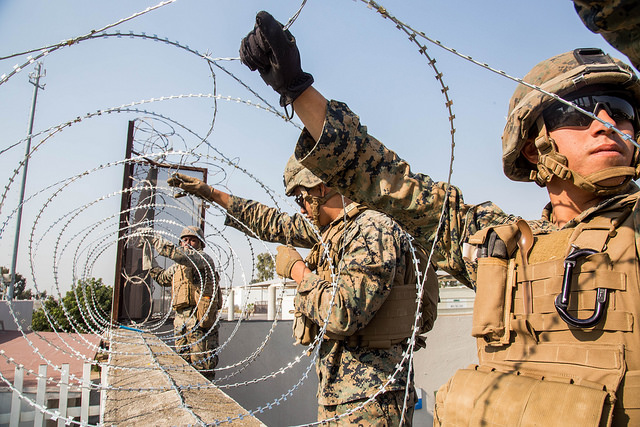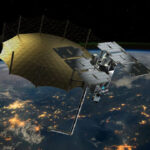Tuesday, November 20th 2018
WASHINGTON (Sinclair Broadcast Group) — The military operation to support Customs and Border Protection (CBP) could soon declare “mission accomplished.”
According to Lt. Gen. Jeffrey Buchanan, the man in charge of the Army’s deployment to the southwest border, the troops sent to reinforce the front line of immigration officers could be home (or redeployed) by Christmas. In an interview with Politico Monday, Buchanan said he expects the Army’s “temporary mission” will end by Dec. 15. “I’ve got no indications from anybody that we’ll go beyond that,” said Buchanan, commanding general of U.S. Army North.
Before the midterm elections, President Donald Trump ordered 5,900 troops to the border to stop what he called an “invasion” by a Central American migrant caravan en route to the United States. Critics argued it was a political stunt and questioned what purpose the active duty troops would serve on top of the 2,100 National Guardsmen who have been deployed to the border since April.
Trump was backed by his Secretary of Defense James Mattis who described the operation as a “moral and ethical mission” to reinforce border patrol. The troops were authorized to support border patrol agents and help them maintain control of the border by providing equipment, transportation, temporary housing, medical teams and engineers to erect temporary barriers along the border.
After roughly three weeks on the ground, Army and Marine engineers have completed three-quarters of their work erecting barriers and hardening ports of entry, Buchanan said. “Once we get the rest of the obstacles built, we don’t need to keep all those engineers here. As soon as I’m done with a capability, what I intend to do is redeploy it,” the general added.
Where that next deployment might be is yet to be determined. There are currently 2,800 troops in Texas, more than 1,500 in Arizona and 1,500 in California, according to U.S. Northern Command.
In a statement Monday, U.S. Army North contradicted Gen. Buchanan’s assertion, saying there was no specific timeline for troops to be redeployed from the southwest border. “We may shift some forces to other areas of the border to engineering support missions in California and other areas,” the statement read. The military will continue to coordinate with the Department of Homeland Security to determine where they are most needed.
In anticipation of violent clashes with migrants, like those seen in Mexico City and last month at the Mexican-Guatemalan border, DHS has pressured the Pentagon to provide armed back up for border patrol personnel. President Trump has also implied the border should be protected by armed soldiers.
Gen. Buchanan confirmed reports of DHS interest in armed troops, according to Politico, but he pushed back on the idea of the military having direct contact with migrants. Under a post-Civil War law, the military is prohibited from engaging in domestic law enforcement activities.
Mattis assured reporters last week that troops will not engage in law enforcement activities along the border “at this time.” He did not rule out the possibility that the Defense Department’s mission could change in the future and troop levels could reach 7,000 if necessary.
The Department of Homeland Security is also keeping all options on the table and appreciated DOD’s continued assistance. In light of potential threats arising from the large number of migrants waiting at U.S. border crossings, DHS spokesperson Katie Waldman said the agency “will not allow our frontline personnel to be in harm’s way.”
So far, the military mission has been dominated by engineers enhancing existing barriers and setting up new ones, said Todd Bensman, a senior national security fellow at the Center for Immigration Studies. Last week, Bensman traveled to South Texas last week to observe the troops stationed near the Hidalgo port of entry.
“Mostly they were beefing up obstacles in anticipation of an extraordinary rush of people coming in between the ports of entry,” Bensman said. He saw troops stringing razor wire along the top and bottom of the existing border wall and laying out “unknown lengths” of it along the nearby river and open spaces. Members of the 19th Engineering Battalion, Fort Riley, Ks., laid razor wire underneath pedestrian and vehicle bridges and military police overlooked the operations carrying side arms. Other soldiers were unarmed.
Further away from the Hidalgo crossing, troops built encampments and erected tents, presumably for border patrol personnel. At multiple sites, heavy construction vehicles, large trucks, humvees and helicopters were arriving and departing moving troops, supplies and equipment.
After concluding his “unofficial embed” with the troops at the border, Bensman said he didn’t have a clear idea what a successful mission will look like. “There are endless barriers that could be built and endless wire that can be strung. I was unaware of any patrolling happening at this stage and maybe they have that planned,” he explained. “But I don’t really know what the end result looks like.”
As the future mission of up to 7,000 troops is being determined, tensions along the border are escalating.
Early Monday morning, CBP and military personnel erected barriers and temporarily suspended all northbound pedestrian and vehicle traffic at the San Ysidro border crossing in San Diego. DHS officials said the action was taken in response to reports of a large number of migrants traveling with caravan planning to “rush the border” and attempt to gain illegal entry. A border rush did not materialize. Traffic lanes were reopened within a few hours at San Ysidro, the busiest southwest border entry point.
Only a few miles south of San Ysidro, thousands of Central American migrants have taken up temporary residence in tents, shelters and on the streets of Tijuana, some waiting for weeks to present themselves to border patrol officers and claim asylum.
KBAK reporter Jeff Platt traveled to Tijuana over the weekend and spoke to a woman from Honduras who had been in line with her children for 45 days waiting to get into the United States. The living conditions are crowded, said one man who was living in a shelter with 2,000 people and expects thousands more to arrive in the coming days.
The backlog of asylum seekers waiting on the Mexican side of the border is expected to grow. This is partly due to Customs and Border Protection implementing “metering” at ports of entry to limit the number of migrants processed each day. DHS has also complained it does not have enough space to detain asylum seekers after they cross the border and await a court hearing. The legal authority to detain immigrants and particularly children for prolonged or indefinite periods is also in question.
The Department of Homeland Security estimates there are roughly 6,000 migrants waiting across the border in Tijuana. Officials say that number could increase to 10,000 as more migrant caravans are traveling north. In recent weeks, CBP has detained an average of 1,500 to 2,000 immigrants trying to cross the border illegally every day.
Those conditions led to protests over the weekend and clashes between local residents demanding the migrants to “go home” and Mexican security forces. The mayor of Tijuana, Juan Manuel Gastelum, expressed frustration with the “avalanche” of migrants, saying the city was ill-prepared to handle them. He also suggested a number of individuals traveling with the caravan were “criminals.”
Local authorities announced this week that they arrested 34 members of the caravan for drug possession, public intoxication, disturbing the peace and resisting police. They will all be deported to their countries of origin.
In a briefing with reporters Monday, a senior DHS official asserted there were 500 criminals traveling with the caravan. Trump repeated the assertion Tuesday, telling reporters that those people would not be coming into the country.
Many of those traveling with the caravan are women and children fleeing violence and persecution in the home countries, explained Gavin Rogers, a Methodist pastor from San Antonio who has been traveling with the caravan. “I have met people on this trip that have had their children kidnapped or possibly been murdered, their cousins and older brothers have been killed,” Rogers told WOAI News. “Most of these people are families.”
DHS and CBP have responded forcefully to the potential for “large-scale civil disturbances” at the border and official ports of entry. On Tuesday, 250 border patrol agents were redeployed from the U.S.-Canada border to supplement San Diego’s CBP station ahead of the arrival of the first migrant caravan. In El Centro, an additional 97 border patrol agents were redeployed to monitor California’ Imperial and Coachella Valleys.
Conditions along the border could become even more chaotic in the coming days following a Ninth Circuit Court ruling to block President Trump’s restriction of asylum seekers.
Trump’s Nov. 9 proclamation said migrants who enter the United States unlawfully between official ports of entry “will be ineligible to be granted asylum.” Judge Jon Tigar issued a temporary restraining order, ensuring immigrants who cross the border illegally can still claim asylum. The White House has indicated it will appeal the ruling in a legal battle that will likely end up in the Supreme Court.






